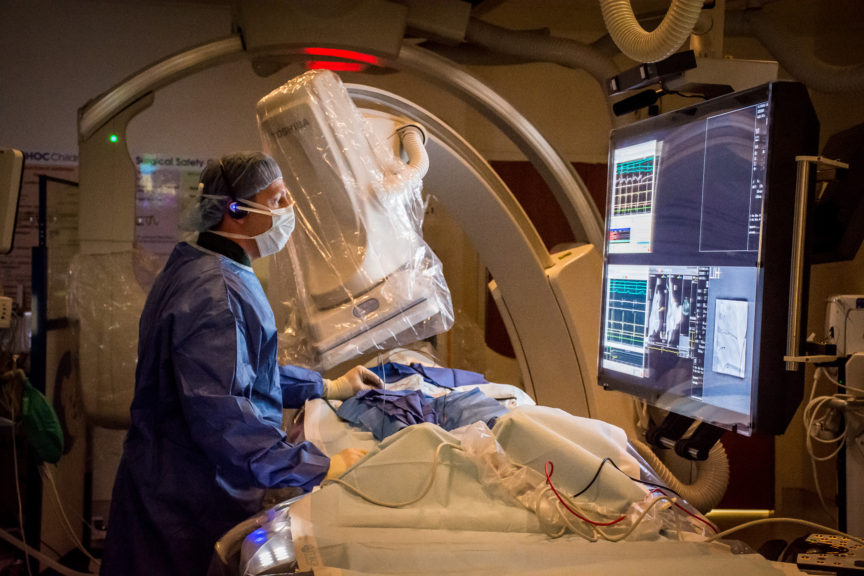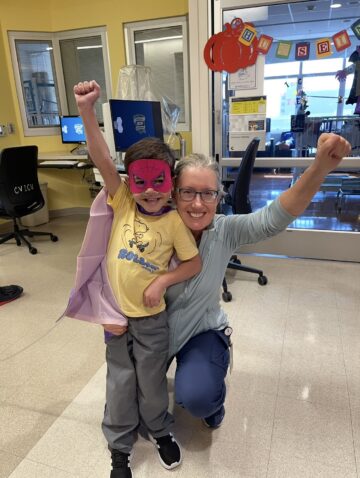A teenaged patient’s longtime arrhythmia has been repaired and her quality of life dramatically improved thanks to emerging technology and the skill of a CHOC cardiologist.
Lauren Flotman, 15, had experienced irregular heartbeats for years before Dr. Francesca Byrne, a pediatric cardiology specialist, diagnosed her with supraventricular tachycardia, or SVT, and Dr. Tony McCanta, a pediatric heart rhythm specialist, repaired the condition through radiofrequency ablation.
The episodes first surfaced when Lauren was about 8 years old and they began increasing in frequency as she aged. They’d occur without warning or pattern.
For Lauren and her family, the sudden attacks caused great concern. Not only was she drained and tired after an episode, but Lauren dreaded them happening, especially during a pep squad routine when her teammates were depending on her.
Lauren was elated to finally have a name for her condition.
“It was a huge relief for sure to have a diagnosis,” she says. “I always had to just describe the feeling because I didn’t have a name. Now I can say I have SVT.”
Lauren’s diagnosis was reached after a Holter monitor captured her heart racing at 220 beats per minute. Dr. Byrne referred Lauren to Dr. McCanta to discuss treatment options, which included anti-arrhythmic medications or an ablation procedure. After reviewing their options carefully, the Flotmans decided to pursue ablation.
For Lauren’s ablation, Dr. McCanta used a new technology called an intracardiac echocardiogram, or ICE, to create a three-dimensional map of the inside of her heart without using fluoroscopy (X-Ray radiation), enabling a catheter to apply radiofrequency energy to the precise location in her heart causing her SVT.
ICE technology involves a tiny ultrasound probe imbedded into a catheter that is advanced through the vein directly into the heart, allowing for very clear, accurate image quality. These ultrasound images then integrate with a three-dimensional electroanatomical mapping system, which acts like a GPS (global positioning system) for the catheters within patients’ hearts, to provide an accurate real-time shell of the inside of the patient’s heart. This allows the doctor to safely move catheters inside the beating heart without using radiation.

While radiofrequency ablation has become a safe and common treatment for SVT in children and adolescents since the mid-2000s, intracardiac echocardiography (ICE) has not traditionally been used in pediatrics due to the large-sized catheters. But when a smaller catheter was created, which was more suitable for the size of young patients, Dr. McCanta and the electrophysiology team from the CHOC Heart Institute were among the first in the world to routinely utilize the new technology in pediatric and adolescent patients.
“For a young, healthy patient like Lauren, increasing safety and minimizing the use of radiation are extremely important, while still being able to provide a cure for her arrhythmia with ablation” says Dr. McCanta.
After a few days of taking it easy following the procedure, Lauren felt back to her usual self – only without the constant fear her heart would suddenly begin racing.

“Our team loves utilizing advanced technologies like ICE and three-dimensional mapping to help children, adolescents, and young adults with heart rhythm problems,” says Dr. McCanta, “Seeing patients like Lauren get back to all of the things they love doing is why we do this!”
Get more expert health advice delivered to your inbox monthly by subscribing to the KidsHealth newsletter here.

Learn more about CHOC’s Heart Institute
CHOC Hospital was named one of the nation’s best children’s hospitals by U.S. News & World Report in its 2024-25 Best Children’s Hospitals rankings and ranked in the cardiology and heart surgery specialties.





